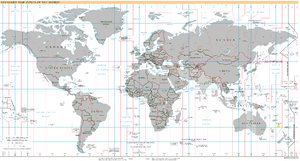UTC+11:30
| UTC+11:30 | |
|---|---|
| Time zone | |
 World map with the time zone highlighted | |
| UTC offset | |
| UTC | UTC+11:30 |
| Current time | |
| 12:30, 2 January 2025 UTC+11:30 [refresh] | |
| Central meridian | |
| 172.5 degrees E | |
| Date-time group | |
| L* | |
UTC+11:30 is an identifier for a time offset from UTC of +11:30.
History
[edit]This time zone has been used as standard time in New Zealand and Norfolk Island, but is no longer used as a time zone anywhere.
On November 2, 1868, New Zealand officially adopted a standard time to be observed nationally, and was perhaps the first country to do so. It was based on the longitude 172° 30' East of Greenwich, that was 11 hours 30 minutes ahead of Greenwich Mean Time. This standard was known as New Zealand Mean Time (NZMT).[1] Today this would be around the same zone covered by UTC+11:30. New Zealand changed from NZMT to New Zealand Standard Time (NZST) as UTC+12:00 in 1946 (after using this time zone as a daylight saving time since 1928, including permanent daylight saving from 1941).[2] It was officially changed to 12 hours in advance of UTC in 1946.[3]
Norfolk Island's standard time (NFT) was on UTC+11:30 until 4 October 2015, when it was changed to UTC+11:00.[4]
See also
[edit]References
[edit]- ^ "Evening Post — 8 April 1929 — OUR TIME". paperspast.natlib.govt.nz. 2011. Retrieved 4 October 2015.
- ^ "Daylight Saving History". New Zealand Department of Internal Affairs. Retrieved 4 October 2015.
- ^ "Daylight Saving". New Zealand Department of Internal Affairs. Retrieved 4 October 2015.
- ^ Hardgrave, Gary (3 September 2015). "Norfolk Island standard time changes 4 October 2015" (Press release). Administrator of Norfolk Island. Retrieved 4 October 2015.
